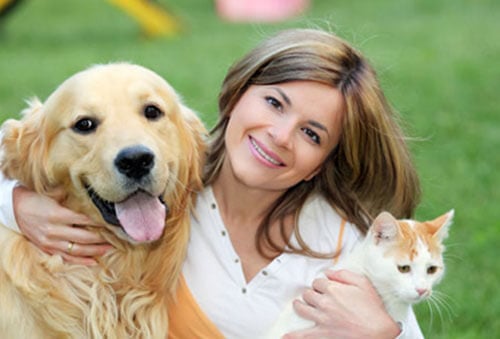There are a number of options available. The one you choose will depend on your personal comfort level, convenience, budget, and what’s best for your pet.
Leaving Your Pet With A Friend
Leaving your pet in the home of a friend, family member or neighbor can be an inexpensive and reassuring solution for you if your pet is familiar and comfortable with the person — and the person is willing and capable. You may want to offer your friend payment, reciprocate by taking her pet when she travels, or simply bring a small thank-you gift when you return.
Say hello before you say goodbye
Before your trip, visit the friend’s home with your pet, several times if possible. You may even want to go on a short errand to get your pet used to the idea that this is a “home away from home.”
Cheery-o
When you say goodbye, whether it’s for an hour or a week, be positive and convey confidence. Sounding apologetic or sad can foster anxiety in your pet. Keep your attitude upbeat and your behavior casual. And leave a favorite chewy toy behind. If your pet does feel nervous, gnawing can help relieve stress.
Packing List
To make your pet more comfortable during his or her visit, pack the following items:
- Your pet’s bed
- Your pet’s food and water bowls
- More food than your pet will need in case you’re delayed getting home
- Favorite treats and toys
- Any medications your pet may need, with clear instructions
- Your vet’s phone number
- A shirt that has been worn one or two times (and not washed) so your pet can have the familiarity of your scent
- Leash and collar with your cell phone number or your friend’s phone number. An otherwise obedient pet may run off to try to find you, so warn your friend to be extra vigilant.
Leaving Your Pet At Home
If you can’t leave your pet at a friend’s home, you may want to arrange for someone to visit your home every day and look in on your pet. While this has the advantage of enabling your pet to stay in the familiar environment of your home, it tends to be better for cats, who don’t need the same level of attention as dogs do.
Caring for your cat
Stopping by once a day to feed your cat, give her fresh water, and tend to the litter box should suffice for a few days, although if your cat craves affection or loves to play, she may need an arrangement that affords her more companionship.
Walking your dog
Having someone stop in once a day is not a good option for dogs. They need to be walked several times a day, and most require more exercise than a quick visit can provide. A dog walker can help.
To find a dog walker, start by asking for referrals. Your vet may know one. Pet parents at a nearby dog run may be able to provide you with names. If you observe a local dog walker who appears to have good control over—and affection for—his or her charges, ask for a business card.
Once you have the name of a dog walker, check references and make sure the walker is bonded and insured. While dog walking is an unlicensed profession, there are professional organizations, like the International Association of Canine Professionals, that provide standards for its members. It’s also a good idea to have a written contract specifying the details of your arrangement. Dog walking rates vary, but for a 20-30 minute walk, the fee is generally around $10-15.
Hiring a pet sitter
For more comprehensive pet care at home, a pet sitter offers companionship and a continuation in your pet’s routine in addition to attending to his or her physical needs. You can opt to have a pet sitter come in several times a day, or to double as a house sitter and remain in residence while you’re away. Pet sitting can cost anywhere from $10-$20 per visit, with overnight rates generally charged as a flat fee of $40-$80.
To find a sitter you and your pet are comfortable with, make an appointment to meet in your home. Here is a list of items to help you conduct your interview:
Fees
Can the sitter quote established fees? What do the fees cover?
Contract
Does the sitter use a formal contract? It should list services performed and the fee for each.
Coverage
Is the sitter bonded and insured? Ask for proof.
Security
Can the sitter provide proof of a background check? Professional pet sitters should have documents verifying that they have no criminal record.
Expectations
How much time will the sitter spend in your home, caring for your pet? A standard amount is 30 minutes, two or three times a day.
Attitude
Does the sitter seem proactive and responsible, professional and competent? Does the sitter seem comfortable in a caretaking role? Do you feel confident entrusting the care of your pet to this person?
The right fit
Does the sitter appear to have the right instinct for handling your pet? Watch how they interact. Does your pet sense that this person is friendly and safe?
Backup
What happens if the sitter gets sick? What if there’s a bad storm? Does the sitter have a contingency plan?
References
Can the sitter easily provide references? When you call them, ask if there was anything they were unhappy with, and whether they would use the sitter again.
Boarding Your Pet
Boarding kennels (which are different than breeding kennels) offer the advantage of having your pet supervised all day long by experienced caretakers. 30,000,000 pet parents in the United States and Canada board their pets each year, and facilities reflect the popularity of this option. While some are no-nonsense and utilitarian, others are downright luxurious. Kennels that earn accreditation from the Pet Care Services Association, a nonprofit trade association (formerly known as ABKA or American Boarding Kennel Association), must comply with over 250 standards. Prices vary depending on which area of the country you’re in, the size of your pet, the type of facility, the services provided, and other criteria, but generally run from $15-$65 per day.
The best way to find a boarding kennel in your area is to get referrals from satisfied customers, research your choice online (many kennels give virtual tours), then make an appointment to visit the facility. If you’re planning to board your pet during a busy time of year, such as the winter holidays, make sure the facility has room. It’s best to start early. Before you board your pet, he or she must be vaccinated.
Here's what to look for on your tour:
The facility should be clean. Daily cleaning procedures using disinfectants should be observed. Solid animal waste should be picked up, areas where pets urinate should be disinfected, and the area should be odor-free. There should be no fleas, ticks or flies.
Pets should be unable to escape. You don’t want your dog or cat locked in a cage all day, but you do want a facility that is designed to prevent an animal from running away. Indoor playrooms should be separated from outdoor areas by more than a single door. Fencing should be sturdy and in good repair. If your dog has been known to dig under or jump over fences, let the facility operator know. Cat areas should always be covered.
Sleeping areas should be separate. Your pet should have a secure space to relax and sleep in without feeling threatened by unfamiliar animals. The area should be clean, dry, and provide enough space for your pet to comfortably stand up, turn around and stretch out. Find out whether you’ll be able to bring your pet’s bed. Most kennels will give you this option, and it can make your pet feel more comfortable.
Pets should look happy and well cared for. If you’re unable to visit the areas where the pets reside, it may be because the facility operator wants to avoid over-stimulating or startling pets who may react unpredictably to strangers. They may also wish to avoid exposing the pets to germs you may bring in with you. They should, however, have viewing windows.
Clean water should be available to each animal. Each pet should have access to his or her own bowl. Feeding procedures vary, with some kennels stocking preferred brands and others asking that you bring your own. Find out the kennel’s policy about sending along your pet’s favorite treats.
Indoor climate should be comfortable. Appropriate temperature and good ventilation are important to a healthy environment. Daytime lighting should also be at an appropriate level.
Exercise areas should provide protection from the elements. This includes direct sunlight as well as inclement weather.
Dogs should have room to run. Some kennels provide each dog with his own exercise area during the day, while others provide exercise time on a rotating basis. You know your dog best, so make sure you find out how much exercise time is permitted. If you feel it’s not enough—or too much—for your pet, let the kennel operator know.
Cats should have roomy quarters. Where they can stretch comfortably and have access to a regularly cleaned litter box. They don’t require the same kinds of exercise areas dogs do, but some kennels provide additional space for cats that enjoy wandering around a bit.
Pets should be monitored by trained professionals. This includes physical and behavioral supervision. A good kennel will employ an experienced staff who can recognize when a pet is distressed or ill. If the facility has group playrooms, personnel should also be able to evaluate behavior and place pets in appropriate groups based on size and play style. Dog playrooms should allow about 75 square feet per dog (less for smaller dogs, more for larger, more active dogs) and have several observant staff members present any time dogs are together.
Less anxiety for your pet — and for you.
Whichever option you choose, the right decision is the one that works for both you and your pet. It should provide for your pet’s physical, mental and emotional well-being, as well as for your peace of mind.
Dogs should be immunized against:
- Rabies
- Distemper
- Hepatitis
- Leptospirosis
- Parainfluenza
- Parvovirus (DHLPP)
- Bordetella (kennel cough)
Cats should be immunized against:
- Rabies
- Panleukopenia (distemper)
- Feline rhinotracheitis
- Calici virus
- Pneumonitis (FVRCPP)






